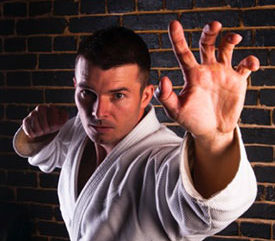The “Gentle Art” of Jiu-Jitsu

Historians of jiu-jitsu say that the origins of the “gentle art” can be traced back to India and were practiced by Buddhist monks. The monks created techniques based upon principles of balance, leverage and manipulating the body for self-defense to avoid the use of weapons. With the expansion of Buddhism, jiu-jitsu spread from Southeast Asia to China, finally arriving in Japan where it developed and gained further popularity. In the last days of the 19th century, some jiu-jitsu masters emigrated from Japan to other continents, teaching martial arts. Today jiu-jitsu is an organized sport with an International Federation and Brazilian National Confederation. Although described as “the gentle art,” jiu-jitsu is a full-contact sport. No one wants to injure a training partner or opponent, but it happens. Jiu-jitsu emphasizes throwing, pinning and joint-locking techniques as compared with martial arts such as karate, which rely more on striking techniques. The best way to avoid injuries in jiu-jitsu is to not treat every training session on the mat as a deathmatch. That doesn’t mean to train hard but does mean to train smart.
Jiu-Jitsu recommendations:
- Use proper protective equipment including headgear, cup and waist belts, mouth guard, safety glasses, and non-skid footwear.
- Maintain fitness to build strength and endurance.
- Warm-up, cool down and hydrate.
- Train to safely execute moves and falling techniques.
- Practice in a well-padded area.
- Be prepared for significant injuries such as dislocations, sprains and fractures. Know the location of the nearest Direct Orthopedic Care for immediate access to orthopedic experts.
The most common jiu-jitsu injuries include:
Shoulder dislocation or separation. Shoulder injuries usually happen when opponents are fighting while standing and one falls, landing on an outstretched arm or shoulder. Symptoms include pain, swelling, inability to move the shoulder, grinding sensation if moved, and deformity. Treatment of a shoulder dislocation involves reducing the dislocation or putting it back in the socket. The reduction is confirmed on an X-ray and the shoulder is then placed in a sling or brace. Treatment of shoulder separation is based on the severity of the injury.
ACL and MCL tears. The ACL ligament is often injured by a twist too far one way. The MCL is on the inside of the knee and susceptible to blows from the side. Symptoms include a popping noise, severe pain, and swelling, inability to move the knee, and limping. Some knee injuries can be treated with immobilization, physical therapy, and anti-inflammatory medicines. Often fractures and injuries around the knee require surgery to fully restore function to the leg. The DOC orthopedic surgeon will diagnose the injury and discuss options and the best course of treatment. Tapping out in jiu-jitsu means giving up and surrendering to an opponent before he or she inflicts serious injury. To avoid jiu-jitsu injury, tapping out may be the smartest move of all to keep the “gentle art” truly gentle.
For more information on the cost of care, click here.




